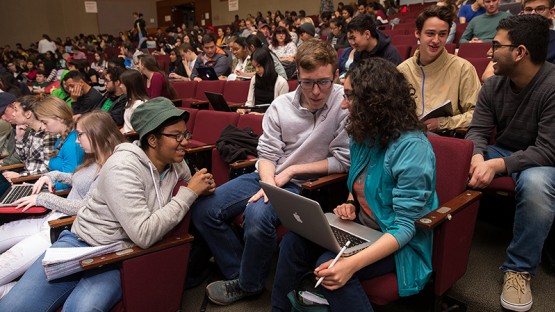Men participated more in an active learning course in science, technology, engineering and math, while women reported lower perceptions of their scientific abilities, were more aware of gender identity and more likely to feel judged based on gender, a new Cornell-led study has found.
In “Gender Differences in Student Participation in an Active Learning Classroom,” published May 26 in CBE–Life Sciences Education, researchers in the Department of Ecology and Evolutionary Biology (EEB), in the College of Arts and Sciences, analyzed student behavior in an introductory biology course at Cornell.
These results suggest that “active learning in itself is not a panacea for STEM equity,” the researchers wrote. “Rather, to maximize the benefits of active learning pedagogy, instructors should make a concerted effort to use teaching strategies that are inclusive and encourage equitable participation by all students.”
Doctoral students Stepfanie Aguillon and Gregor-Fausto Siegmund led the study, which included former EEB graduate student teaching assistants, lecturers and postdoctoral fellows. Cissy Ballen, a former EEB postdoc who’s now at Auburn University, and Abby Drake, a senior lecturer in the department and an Active Learning Initiative fellow, were instrumental in developing the study.
The “flipped classroom” approach of the active learning model incorporates in-class activities, group work, real-time surveys and other tools to help students apply knowledge through deliberate practice during class time.
Numerous studies documenting the benefits of active learning for many demographic groups have led to a shift in teaching that requires students to interact more in the classroom, particularly in STEM courses.
“A lot of work has been done showing that the transition to active learning in this course was beneficial for students from underrepresented backgrounds,” said Aguillon, who was a teaching assistant in the course during the study. “We wanted to go one step further to understand how students actually experience the classroom environment once active learning methods are used.”
They focused on student gender because research suggests women participate less in interactions in front of whole classes. They sought to determine whether active learning strategies such as structured activities or clicker questions promote equitable participation by all students.
To find out, researchers observed students in this course over two semesters, recording students’ interactions with the instructor across seven categories, including unprompted comments and questions; prompted responses from individuals; prompted responses from groups; and student interaction with the instructor during small group activities.
The researchers also collected student grades and conducted surveys to assess students’ awareness of gender identity in the classroom (salience of gender identity) and to measure their perceptions of their own capability to undertake science tasks (self-efficacy).
Before the study, the researchers hypothesized that active learning practices such as peer discussion and clicker questions would result in parity between genders. Instead, they observed that men participated more than women in all interaction types except for group work (in one semester of the study). This result, together with men’s higher rates of scientific self-efficacy and relative lack of worry about gender stereotypes, points to a need to further adjust participation plans in active learning classroom, they said.
“Research from Cornell and elsewhere suggests that active learning reduces performance gaps in STEM classes, and we thought that might translate to reducing participation gaps, as well,” said Siegmund. “For us, it emphasizes that the instructor is really setting the stage for the students to act – and what that stage looks like can matter.”
This study grew out of a project with Cornell’s Scholarship of Teaching and Learning Program, now part of the Future Faculty and Academic Careers program.
The publication of this work was supported by the Future Faculty and Academic Careers program.
Kate Blackwood is a writer for the College of Arts and Sciences.















